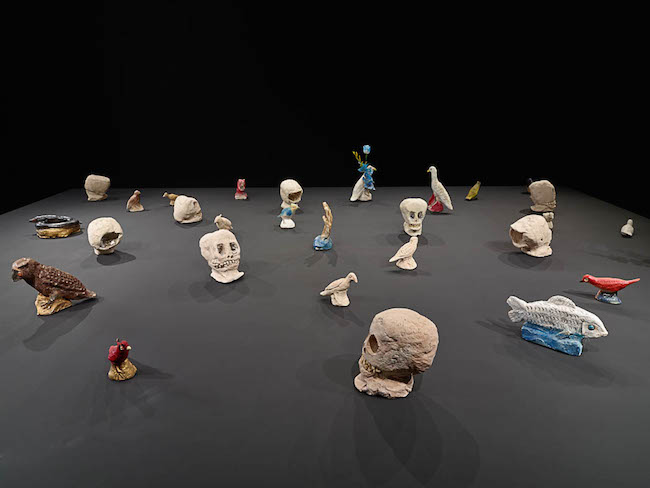For the first time since his death in 1993, the ceramics of James “Son Ford” Thomas will be presented in their own solo exhibition. James ‘Son Ford’ Thomas: The Devil and His Blues is showing at the 80 Washington Square East Gallery at New York University until Aug. 7.

Thomas is known to fans of Delta Blues music. He was born near Eden, Mississippi in 1926. He grew up partying in “jook joints” and was exposed to the traveling musicians who played there. He wrapped this influence into his own songwriting and started a musical career that chronicled life in the detail. You can watch him playing bottleneck guitar here.
As a child he sculpted his own toys out of clay, using that experience to create his iconic skulls and heads. The skulls have their narrative background, based in life on the Delta, folk spirituality and Thomas’ own grim outlook and sense of humor. From the gallery:
“The skulls for which Thomas became known were first made as a mischievous ten-year-old, with the purpose of scaring his grandfather. After a ten-year period working as a gravedigger, from 1961-71, Thomas began making skulls again, this time with the aim of accurately representing the dead, often using real human teeth or dentures and a dull white paint he created to simulate the look of bones. He deemed these works inappropriate for children, yet also intended that they be used as utilitarian objects including pencil holders and ashtrays. After his time working as a gravedigger, while reflecting on his sculpture and the topic of death, Thomas stated, ‘We all end up in the clay.’”


The gallery recognizes that Thomas’ two art forms— blues and ceramics— grew together side-by-side. A record of Thomas’ music plays throughout the exhibition, with an attendant on hand to flip the album over once a side finishes. Roberta A. Smith, writing for the New York Times, talks about the interplay between the sound and the skull.
“They (the skulls) seem electrified, perhaps moved by the Holy Spirit, or by the blues. Their abandon evokes Thornton Dial’s charcoal drawings of faces framed in undulant, slightly hallucinatory lines.
“The plainer ones seem more thoughtful and nuanced. Once their gravity sinks in, the others gain it, too, conveying different personalities.
“In the end, most of the heads become so realistic — and mysterious — they could be people having their photographs taken, doing nothing yet revealing a lot.”

Will Heinrich, writing for HyperAllergic, describes the connection Thomas’ skulls and heads have on the viewer:
“By emphasizing the usually unremarked aspect of each type of portrait, Thomas, a believer in the African-American folk tradition called “hoodoo,” created a squalidly majestic, decidedly anti-modern, shockingly Manichaean, and radically unsentimental picture of the way human lives are lived in flesh and in time. It’s not only unmoving stuff that endures, his work says to me, but also the momentary flashes of insight, emotion, and wit. The same flashes that evaporate if they’re not immediately committed to music, conversation, or art — the same flashes that are inescapably consigned to rotting flesh — reappear after every defeat, and we can always recognize them. In some of his ghostly smiles, Thomas mixed in dentures and pebbles along with real teeth; in one case, he used kernels of corn and had to trim them when they sprouted.”
Any thoughts about this post? Share yours in the comment box below.



Works from “James ‘Son Ford’ Thomas: The Devil and His Blues” at 80WSE Gallery. Photographs courtesy of the gallery.

James “Son Ford” Thomas



Add your valued opinion to this post.